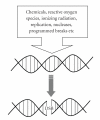Plant DNA recombinases: a long way to go
- PMID: 20798837
- PMCID: PMC2925088
- DOI: 10.4061/2010/646109
Plant DNA recombinases: a long way to go
Abstract
DNA homologous recombination is fundamental process by which two homologous DNA molecules exchange the genetic information for the generation of genetic diversity and maintain the genomic integrity. DNA recombinases, a special group of proteins bind to single stranded DNA (ssDNA) nonspecifically and search the double stranded DNA (dsDNA) molecule for a stretch of DNA that is homologous with the bound ssDNA. Recombinase A (RecA) has been well characterized at genetic, biochemical, as well as structural level from prokaryotes. Two homologues of RecA called Rad51 and Dmc1 have been detected in yeast and higher eukaryotes and are known to mediate the homologous recombination in eukaryotes. The biochemistry and mechanism of action of recombinase is important in understanding the process of homologous recombination. Even though considerable progress has been made in yeast and human recombinases, understanding of the plant recombination and recombinases is at nascent stage. Since crop plants are subjected to different breeding techniques, it is important to know the homologous recombination process. This paper focuses on the properties of eukaryotes recombinases and recent developments in the field of plant recombinases Dmc1 and Rad51.
Figures


Similar articles
-
Fission yeast rad51 and dmc1, two efficient DNA recombinases forming helical nucleoprotein filaments.Mol Cell Biol. 2005 Jun;25(11):4377-87. doi: 10.1128/MCB.25.11.4377-4387.2005. Mol Cell Biol. 2005. PMID: 15899844 Free PMC article.
-
Sequence imperfections and base triplet recognition by the Rad51/RecA family of recombinases.J Biol Chem. 2017 Jun 30;292(26):11125-11135. doi: 10.1074/jbc.M117.787614. Epub 2017 May 5. J Biol Chem. 2017. PMID: 28476890 Free PMC article.
-
Meiotic recombination: an affair of two recombinases.Cell Cycle. 2004 Nov;3(11):1375-7. doi: 10.4161/cc.3.11.1364. Epub 2004 Nov 20. Cell Cycle. 2004. PMID: 15547324
-
Roles of RecA homologues Rad51 and Dmc1 during meiotic recombination.Cytogenet Genome Res. 2004;107(3-4):201-7. doi: 10.1159/000080598. Cytogenet Genome Res. 2004. PMID: 15467365 Review.
-
Structure/function relationships in RecA protein-mediated homology recognition and strand exchange.Crit Rev Biochem Mol Biol. 2015;50(6):453-76. doi: 10.3109/10409238.2015.1092943. Epub 2015 Oct 13. Crit Rev Biochem Mol Biol. 2015. PMID: 26459995 Review.
References
-
- Cox MM. Recombinational DNA repair of damaged repliction forks in Escherichia coli: questions. Annual Review of Genetics. 2001;35:53–82. - PubMed
-
- Shinohara A, Ogawa H, Ogawa T. Rad51 protein involved in repair and recombination in S. cerevisiae is a RecA-like protein. Cell. 1992;69(3):457–470. - PubMed
LinkOut - more resources
Full Text Sources
Research Materials

